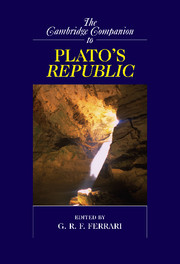Book contents
- Frontmatter
- 1 The Protreptic Rhetoric of the Republic
- 2 The Place of the Republic in Plato’s Political Thought
- 3 Rewriting the Poets in Plato’s Characters
- 4 Wise Guys and Smart Alecks in Republic 1 and 2
- 5 Justice and Virtue: The Republic’s Inquiry into Proper Difference
- 6 The Noble Lie
- 7 The Three-Part Soul
- 8 Eros in the Republic
- 9 The Utopian Character of Plato’s Ideal City
- 10 Philosophy, the Forms, and the Art of Ruling
- 11 Sun and Line: The Role of the Good
- 12 Beginning the “Longer Way”
- 13 The City-Soul Analogy
- 14 The Unhappy Tyrant and the Craft of Inner Rule
- 15 What Is Imitative Poetry and Why Is It Bad?
- 16 The Life-and-Death Journey of the Soul: Interpreting the Myth of Er
- Bibliography
- Index of Passages
- Index of Names and Subjects
- Series List
13 - The City-Soul Analogy
Published online by Cambridge University Press: 28 November 2007
- Frontmatter
- 1 The Protreptic Rhetoric of the Republic
- 2 The Place of the Republic in Plato’s Political Thought
- 3 Rewriting the Poets in Plato’s Characters
- 4 Wise Guys and Smart Alecks in Republic 1 and 2
- 5 Justice and Virtue: The Republic’s Inquiry into Proper Difference
- 6 The Noble Lie
- 7 The Three-Part Soul
- 8 Eros in the Republic
- 9 The Utopian Character of Plato’s Ideal City
- 10 Philosophy, the Forms, and the Art of Ruling
- 11 Sun and Line: The Role of the Good
- 12 Beginning the “Longer Way”
- 13 The City-Soul Analogy
- 14 The Unhappy Tyrant and the Craft of Inner Rule
- 15 What Is Imitative Poetry and Why Is It Bad?
- 16 The Life-and-Death Journey of the Soul: Interpreting the Myth of Er
- Bibliography
- Index of Passages
- Index of Names and Subjects
- Series List
Summary
Translated by G. R. F. Ferrari
In the Republic Plato's fictional character Socrates develops an elaborate argument to support the thesis that justice pays, because only the just, not the unjust, have access to happiness. The procedure that Socrates adopts in order to make this argument is of a special sort. He derives claims about the human soul from claims that he makes about human society - the polis or “city.” It is a procedure of crucial importance within the work as a whole.
Where and how is the comparison between city and soul introduced (section I)? What developments does it subsequently undergo (section II)? In which passages of the dialogue are characteristics of the soul derived from characteristics of the city, and what are these characteristics (section III)? How far does the similarity between city and soul extend, and what does Socrates do when he comes up against its limits (section IV)? How does the fact that the procedure is analogical influence the conception of the soul (section V) and of the city (section VI) in this dialogue? What role do causal relations between city and soul have to play - city coming to be formed by soul (section VII), and soul coming to be formed by city (section VIII)?
The interpretation presented in this chapter is one that I have elsewhere substantiated against the background of the extensive scholarly literature on the topic. I can do no more than allude to this debate here. Often, where I differ from the (older) scholarly consensus, those points of difference result from a broader difference of methodology. Accordingly, I offer a brief account of my methodology in section IX. The chapter concludes with a summary of its results (section X).
- Type
- Chapter
- Information
- The Cambridge Companion to Plato's Republic , pp. 345 - 385Publisher: Cambridge University PressPrint publication year: 2007
- 24
- Cited by



